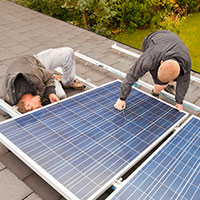Cost of solar panels in Vermont
How much is it to go solar in 2023?

The average solar panel system costs $12,054 in Vermont. Going solar in Vermont is 1.5% more expensive than the national average. The out-of-pocket investment might be higher compared with other states, but your total lifetime savings are also higher (thanks to Vermont’s high energy costs).
Key insights
- The average cost per watt is $3.14.
- Total lifetime savings average $26,468.
- If you pay cash, the average payback period is nine years.
How much do solar panels cost in Vermont?
In general, installing residential solar panels costs $10,000 to $30,000 or more. A lot of solar customers in Vermont finance their systems, so there’s a monthly fee until the loan is paid off.
“It's a big investment,” Bonnie in Burlington (a ConsumerAffairs reviewer) told us. “I look at it like, Okay, I'm paying $147 a month. But I pay more than that for insurance on my house.”
Average cost by system size in Vermont
| 3 kW | 5 kW | 6 kW | 8 kW | 10 kW | |
|---|---|---|---|---|---|
| Cost before federal tax credits | $8,910 | $14,850 | $17,820 | $23,760 | $29,700 |
| Cost after federal tax credits | $6,593 | $10,989 | $13,187 | $17,582 | $21,978 |
Are solar panels worth it in Vermont?
“I don't see any downsides at all in going solar. You’re always saving money,” Patricia in Burlington told us. “You’re paying a certain amount. They give you this amount that you’re paying every month, and it doesn’t change. My electric bill has gone down considerably even with these two accounts I’ve got on in Lincoln. The savings was great. I'm buying another property that I'm definitely gonna put the solar panels on.”
Financially, solar panels are worth it if your ongoing costs are lower than your electric bill. On average, solar panels take about nine years to pay for themselves and save homeowners a little more than $26,000 over a lifetime. Going solar makes sense environmentally, too, because it reduces emissions.
» STILL NOT SURE? Solar energy pros and cons
Cost factors of going solar in Vermont
How much you actually pay to go solar depends on a range of factors, including the size of your system and the quality of your panels.
More panels, higher costs
The cost of a solar power system is generally proportional to its size. The more panels you have (and the larger the system's total wattage), the higher the price will be — you're paying for more equipment plus potentially more labor to install the system.
But there can be some economies of scale with larger systems. For instance, a bigger system costs more in absolute terms, but the cost per watt of capacity will likely decrease as the system size increases.
Panel efficiency
Solar panels come in various efficiencies, meaning some panels can produce more electricity than others of the same size. The average solar panel efficiency is about 15% to 20%.
If you have a small roof or limited space for installing solar panels, get panels with higher efficiency ratings to make the most of the space you have. However, if space is not an issue, it may be more cost-effective to install lower-efficiency panels.
Investing in quality panels can save you more money over the long term because they generate more power over the life of the system. In other words, the higher the efficiency, the more power can be produced per square foot. This means you can generate the same amount of energy with fewer panels.
» COMPARE: Most efficient solar panels
Condition of your roof
If your roof is not in good condition, you might have to spend extra money to repair or replace it before installing solar panels. Most panels are designed to last 25 years or more, so you need your roof to last at least as long.
Otherwise, you’ll have to pay to remove the panels, repair your roof and reinstall them, which can cost thousands of dollars. (Asphalt shingles generally last 20 to 30 years, and metal roofs last a little longer.)
Solar panels typically last 25 years
If your roof faces north or is heavily shaded, your system might produce less electricity than anticipated. The pitch (or slope) of your roof is also important, especially during the winter months.
John in Mount Holly told us their panels don't make power when covered in snow: “If I had a steeper pitch, the snow probably would slide off on its own. But because of a low pitch on my roof, the snow tends to stick. So, every winter, I'm used to going up on my roof, shoveling snow off. That's fine. But it's when my entire roof is covered in solar panels and I have to be gingerly pulling it off, then it becomes kind of an issue. And it's more time-consuming.”
So, if your roof isn’t ideal to support panels, you might need a bigger system to generate 100% of your power needs.
» GUIDE: Solar panel installation guide
Solar incentives, tax credits and rebates in Vermont
Taking advantage of the federal solar investment tax credit (ITC) is the best way to save on the upfront cost of going solar in Vermont (and most other states right now). In addition to ITC, residents can take advantage of local financial incentives — Green Mountain Power offers some rebates and a popular utility net metering program in Vermont.
Vermont has a blanket 100% property tax exemption for solar systems up to and including 10 kilowatts. There is also an exemption on 100% of all applicable sales taxes on the purchase of a solar power system.
The average ITC value in Vermont is $5,652.
If your solar panel system is connected to the power grid (as most are), you can take advantage of net metering. This is a system where you can sell excess electricity that your panels generate back to the utility company, potentially offsetting the cost of your loan payments.
» LEARN MORE: Vermont solar incentives
Compare solar installation companies in Vermont
“Vermont has some local companies. But I didn't go with local because they haven't been around as long,” a Sunrun customer in Burlington told us. “I wanted a company that has been through a lot of the stuff and has been doing it for years.”
» COMPARE: Best solar companies
| SunPower | Sunrun | ShopSolar | |||||
|---|---|---|---|---|---|---|---|
| Primary | SunPower | Read reviews | Customer Ratings 4.3 | Free consultation | Payment options
Cash, loan, lease
| Warranty
10 to 25 years
| |
| Primary |  | Sunrun | Read reviews | Customer Ratings 4.1 | Free consultation | Payment options
Cash, loan, lease
| Warranty
25 years
|
| Primary |  | ShopSolar | Read reviews | Customer Ratings 4.7 | Free consultation | Payment options
Cash, loan
| Warranty
Varies
|
FAQ
How can I pay for solar panels?
You can pay cash, but most people finance solar panels. A solar loan works a lot like any other type of loan — there’s an application and approval process, and you pay it back over time (with interest).
If you are considering a solar loan, lease or PPA (power purchase agreement), always ask:
- Is there a down payment?
- How much will I pay per month?
- When will monthly payments increase, and by how much?
How much can I save with solar panels?
It really depends on your energy usage. “My power bill is nonexistent. I pay for the meter and Sunrun,” Dwight in Proctor told us. “But I’m pulling very little, if any, power from the grid.”
Vermont's average monthly electric bill is $109.24, according to the U.S. Energy Information Administration. The high electricity rates are partially what’s driven the demand for alternatives — solar panels can eliminate your electric bill and make you money on any excess power that you produce.
It also depends on how you pay for the system. If you get a loan, then you have to pay that off each month. For example, Edward in Colchester pays $82 each month to their solar company, “which was the equivalent of my electric bill. There was a $26 minimum charge that they charge to bring out the power, so I had to pay that. It was basically the same as what I was paying for my electric service in the past, so it’s not like I am saving any money.”
How does net metering work in Vermont?
Vermont’s net metering statute lets residents install and operate their own energy systems. You’ll pay a standard rate (though rates are subject to certain conditions to ensure safety and reliability). To get permission to operate your solar system and benefit from net metering, you need to fill out a Net-Metering Registration Form and get a Certificate of Public Good from the Vermont Public Service Board (PSB).
A ConsumerAffairs reviewer, Courtland in West Windsor, told us their array is on a small cottage: “I'm net negative, so grid connected, but exclusively using solar power in the aggregate. My project is in Vermont where it's not sunny all the time, but if I look at it over the course of the year, it generated more power than I use.”
» LEARN: What is net metering?
Will my solar panels work on cloudy days?
Yes, solar panels will work on cloudy days. However, your power output may decrease by about 20% on days with thick overhead cloud coverage, according to the Environmental and Energy Study Institute.
» LEARN: How do solar panels work?
Bottom line
The Green Mountain State is the most environmentally friendly state in 2023 — it has the lowest emissions per capita (0.06 tons of greenhouse gas emissions per person) and generates 99.7% of its energy from renewable resources, by far the most in the U.S.
There's strong community support for renewable energy initiatives in Vermont. The state has one of the highest rates of participation in green energy programs in the nation. Several towns and cities in Vermont have committed to 100% renewable energy targets, reflecting a broader statewide push for sustainability.
This is partially because the state’s economy is so tied to natural resources, “from our seasonal recreation businesses to farming,” according to Jennifer Rushlow, dean of Vermont School for the Environment at Vermont Law and Graduate School, “and there seems to be a prevailing sense that those resources require some protection.”
Article sources
- EcoWatch, “ Solar Panel Cost in Vermont .” Accessed July 17, 2023.
- Office of Energy Efficiency & Renewable Energy, “ Homeowner’s Guide to the Federal Tax Credit for Solar Photovoltaics .” Accessed July 12, 2023.
- Environmental and Energy Study Institute, “ Solar Energy .” Accessed July 18, 2023.
- Solar Energy Industries Association, “ Vermont Solar .” Accessed July 18, 2023.
- Vermont Public Service Department, “ A Vermonter’s Guide to Residential Solar .” Accessed July 18, 2023.
- Database of State Incentives for Renewables & Efficiency (DSIRE), “ Vermont database .” Accessed July 17, 2023.
You’re signed up
We’ll start sending you the news you need delivered straight to you. We value your privacy. Unsubscribe easily.
